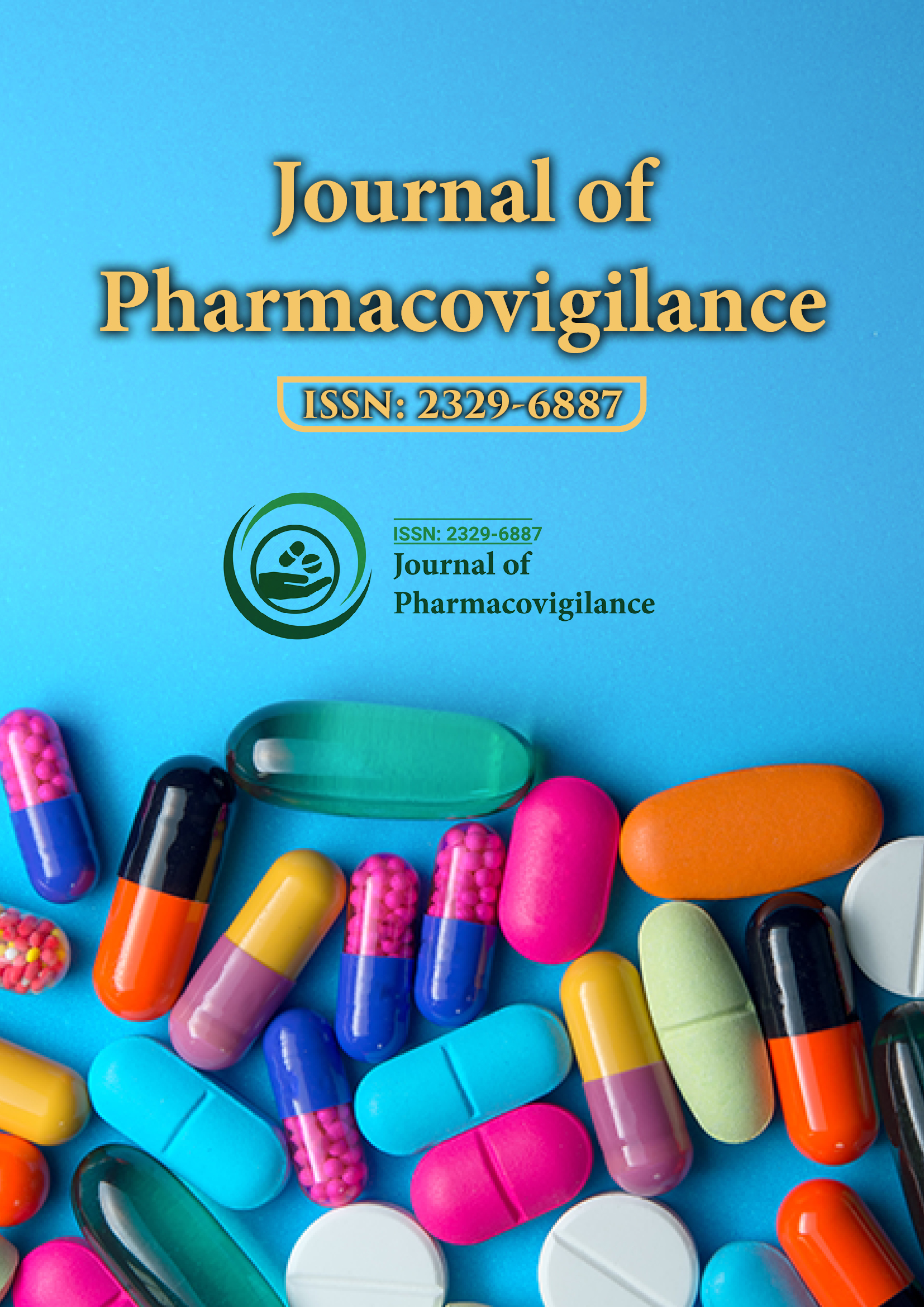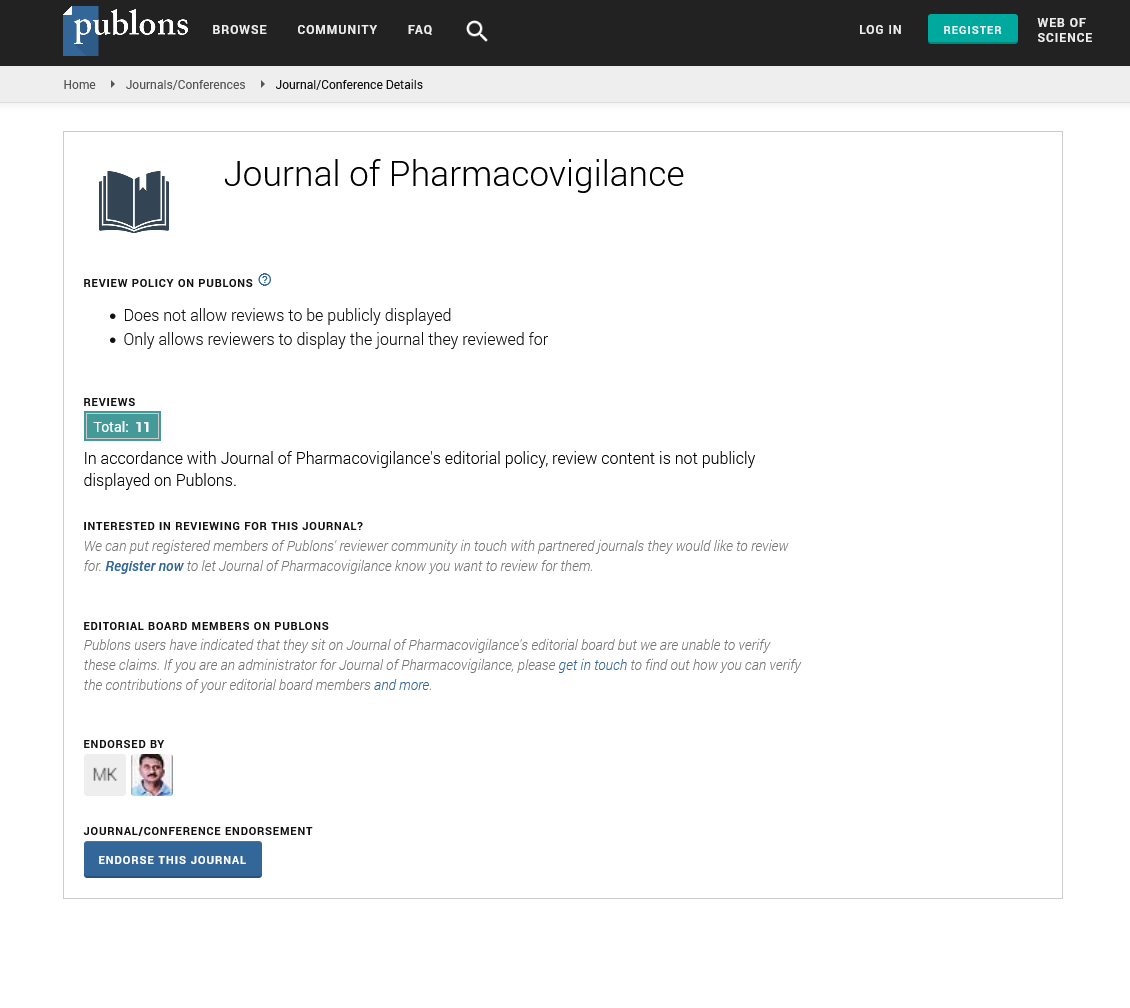Indexed In
- Open J Gate
- JournalTOCs
- The Global Impact Factor (GIF)
- RefSeek
- Hamdard University
- EBSCO A-Z
- OCLC- WorldCat
- Publons
- Euro Pub
- Google Scholar
Useful Links
Share This Page
Journal Flyer

Open Access Journals
- Agri and Aquaculture
- Biochemistry
- Bioinformatics & Systems Biology
- Business & Management
- Chemistry
- Clinical Sciences
- Engineering
- Food & Nutrition
- General Science
- Genetics & Molecular Biology
- Immunology & Microbiology
- Medical Sciences
- Neuroscience & Psychology
- Nursing & Health Care
- Pharmaceutical Sciences
Opinion Article - (2024) Volume 12, Issue 1
Leveraging Big Data and Machine Learning to Enhance Pharmacovigilance Signal Detection
FengLin Chen*Received: 29-Feb-2024, Manuscript No. JP-24-25636; Editor assigned: 01-Mar-2024, Pre QC No. JP-24-25636(PQ); Reviewed: 15-Mar-2024, QC No. JP-24-25636; Revised: 22-Mar-2024, Manuscript No. JP-24-25636(R); Published: 29-Mar-2024, DOI: 10.35248/2329-6887.24.12.465
About the Study
Ensuring drug safety is a continuous activity in the dynamic world of medicine. Pharmacovigilance, the science dedicated to monitoring drug effects, plays a vital role. Traditionally reliant on spontaneous Adverse Event (AE) reporting, pharmacovigilance has faced limitations due to underreporting and delays. However, the advent of big data and Machine Learning (ML) offers a transformative approach to pharmacovigilance signal detection.
Big data of pharmacovigilance information
Big data refers to vast, intricate, and diverse datasets that hold immense potential for uncovering hidden patterns. In pharmacovigilance, big data encompasses a broad spectrum of sources:
• Detailed patient information, including medications, diagnoses, and lab results, resides within EHRs. Analyzing this data allows for the identification of potential drug-AE associations [1-3].
• Traditional reporting systems can be integrated with big data platforms, enabling faster analysis and identification of reporting clusters.
• Social media platforms provide a unique window into patient experiences. Natural Language Processing (NLP) techniques can be used to mine social media for discussions of AEs and potential drug interactions [4].
• Insurance claims data can reveal trends in healthcare utilization, potentially indicating associations between drugs and specific medical conditions.
Machine learning: The engine for extracting insights from big data
ML algorithms excel at identifying patterns in complex datasets. In pharmacovigilance, ML can be harnessed for several key tasks:
• ML algorithms can analyze vast amounts of data to identify statistically significant increases in the reporting of specific AEs associated with a particular drug. This allows for earlier detection of potential safety concerns [5,6].
• ML can uncover subtle patterns in data that might be missed by traditional methods. This can lead to the identification of previously unknown drug interactions or adverse event profiles [7-9].
• ML models can be used to identify patients at higher risk of experiencing specific AEs based on demographics, medical history, and medication use. This enables targeted interventions and enhanced patient safety.
The power of big data and machine learning
The integration of big data and ML offers compelling advantages for pharmacovigilance:
• ML algorithms can analyze data much faster than traditional methods, enabling earlier detection and response to potential safety signals.
• Big data provides a more comprehensive view of drug safety, allowing for the identification of signals that might be missed through spontaneous reporting alone.
• By identifying patients at higher risk, ML facilitates proactive interventions and personalized medicine approaches.
• Real-world data from big data sources can provide valuable insights into the effectiveness and safety of drugs in actual clinical practice [10].
Challenges and considerations
While big data and ML, potential for pharmacovigilance, certain challenges need to be addressed:
• The quality and consistency of data across different sources are crucial for accurate analysis. Standardization efforts are essential for maximizing the value of big data.
• Protecting patient privacy is important. Secure data handling practices and anonymization techniques are necessary.
• ML algorithms can perpetuate biases present in the data they are trained on. Careful selection and validation of training data are essential to mitigate bias.
• Regulatory frameworks need to evolve to accommodate the use of big data and ML in pharmacovigilance, ensuring data integrity and patient safety.
Conclusion
The convergence of big data and machine learning presents a transformative opportunity for pharmacovigilance. By controlling the power of these technologies, we can move towards a future of proactive drug safety monitoring, ultimately leading to safer and more effective medications for patients worldwide.
References
- Terzano C, Conti V, Di Stefano F, Petroianni A, Ceccarelli D, Graziani E, et al. Comorbidity, hospitalization, and mortality in COPD: results from a longitudinal study. Lung. 2010;188:321-329.
[Crossref] [Google Scholar] [PubMed]
- Decramer M, Janssens W, Miravitlles M. Chronic obstructive pulmonary disease. Lancet. 2012;379(9823):1341-1351.
[Crossref] [Google Scholar] [PubMed]
- Solano JP, Gomes B, Higginson IJ. A comparison of symptom prevalence in far advanced cancer, AIDS, heart disease, chronic obstructive pulmonary disease and renal disease. J Pain Symptom Manage. 2006;31(1):58-69.
[Crossref] [Google Scholar] [PubMed]
- Cheng JS, Huang WF, Lin KM, Shih YT. Characteristics associated with benzodiazepine usage in elderly outpatients in Taiwan. Int J Geriatr Psychiatry. 2008;23(6):618-624.
[Crossref] [Google Scholar] [PubMed]
- Light RW, Merrill EJ, Despars JA, Gordon GH, Mutalipassi LR. Prevalence of depression and anxiety in patients with COPD: relationship to functional capacity. Chest. 1985;87(1):35-38.
[Crossref] [Google Scholar] [PubMed]
- Kontopoulou K, Iosifidis E, Antoniadou E, Tasioudis P, Petinaki E, Malli E, et al. The clinical significance of carbapenem-resistant Klebsiella pneumoniae rectal colonization in critically ill patients: from colonization to bloodstream infection. J Med Microb. 2019; 68(3):326-35.
[Crossref] [Google Scholar] [PubMed]
- Li Y, Shen H, Zhu C, Yu Y. Carbapenem-resistant Klebsiella pneumoniae infections among ICU admission patients in central China: Prevalence and prediction model. BioMed Res Int. 2019; 9767313.
[Crossref] [Google Scholar] [PubMed]
- Forde C, Stierman B, Ramon-Pardo P, Dos Santos T, Singh N. Carbapenem-resistant Klebsiella pneumoniae in barbados: driving change in practice at the national level. PLoS One. 2017; 12(5):e0176779.
[Crossref] [Google Scholar] [PubMed]
- Marsh JW, Mustapha MM, Griffith MP, Evans DR, Ezeonwuka C, Pasculle AW, et al. Evolution of outbreak-causing carbapenem-resistant Klebsiella pneumoniae ST258 at a tertiary care hospital over 8 years. MBio. 2019; 10(5):e01945-1919.
[Crossref] [Google Scholar] [PubMed]
- Humphries RM, Yang S, Kim S, Muthusamy VR, Russell D, Trout AM, et al. Duodenoscope-related outbreak of a carbapenem-resistant klebsiella pneumoniae identified using advanced molecular diagnostics. Clin Infect Dis. 2017; 65(7):1159-1166.
[Crossref] [Google Scholar] [PubMed]
Citation: Chen F (2024) Leveraging Big Data and Machine Learning to Enhance Pharmacovigilance Signal Detection. J Pharmacovigil. 12:465.
Copyright: © 2024 Chen F. This is an open-access article distributed under the terms of the Creative Commons Attribution License, which permits unrestricted use, distribution, and reproduction in any medium, provided the original author and source are credited.

